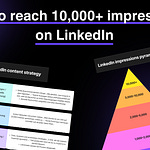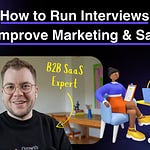Problem-solution fit is one of the most important early milestones for any startup — but also one of the hardest to assess.
What does it really mean to have ‘problem–solution fit’ (PSF) and how do you know you’ve reached it?
In my latest conversation with Dr. Judit Klein, Head of Startups at ZOLLHOF Tech Incubator, we unpacked this critical early-stage milestone. With deep experience supporting B2B SaaS founders, Judit shared a clear, practical view of how to approach, define, and validate problem–solution fit.
Here’s a structured summary of what she shared:
New here? Each week, I share practical marketing strategies, tactics and learnings designed to help you scale your B2B business to €1 million ARR and beyond 🚀
Make sure to subscribe to not miss out on any episode!
1. Problem–Solution Fit Is a Learning Process
Judit emphasizes that problem–solution fit is not a binary yes/no moment. Instead, it’s a process of continuous learning about your users, their context, and your product's role in their workflow.
She often sees teams approaching this with the right mindset, but lacking structured feedback loops or data to guide their decisions.
"You don’t need to over-engineer it. But you need a clear sense of what you’re validating, and how your product fits into the user’s world."
2. Focus on the Problem First — Not the Product
Judit emphasized that many founders come in with a strong product idea or even an MVP, but they haven’t deeply validated the actual problem it solves.
"You need to fall in love with the problem, not your product."
She advises:
Spend time understanding the day-to-day of your target audience
Get specific about the problem context: when, why, and how it shows up
Don’t just ask “Is this a problem?” — dig into how painful or frequent it really is
3. Talk to the Right People
A common mistake: getting feedback from people who are not the real users.
"We often talk to people we have easy access to, but they might not be the decision-makers or even the actual users."
Instead:
Make sure you're speaking to the right roles (end-users and decision-makers).
Creating assumption maps: What do you believe about the problem, the user, their goals?
Defining clear questions that test those assumptions
Keeping interviews problem-focused (not pitching your solution)
Watch how they work. Ask: "Can you show me how you solve this today?"
4. Use AI to Test Assumptions Early and Speed Up The Process — but Don’t Skip Real Conversations
One standout point Judit shared: AI can be a powerful early tool for lean teams.
“You can basically have your own team just based on AI... It allows you to test assumptions and gather directional feedback before you even talk to the first human being.”
Use tools like ChatGPT to:
Draft ideal customer profiles and test messaging angles
Simulate early objections or pain point articulation
Generate interview scripts or refine your hypothesis
Important: This is not a replacement for real interviews. But it helps you prepare smarter and move faster.
Placeholder for graphic: “A side-by-side chart comparing Early Validation With vs. Without AI — showing reduced time, clearer hypotheses, better prep for user interviews.”
5. Don't Skip the Fundamentals
Founders often move too quickly into product development without having nailed the user problem.
"The real work is understanding user workflows, pain points, and priorities. That takes time, but it’s the foundation for everything else."
Problem–solution fit is fuzzy, but Judit sees clear signals in the teams who are approaching it.
Signals that you are getting closer to PMF:
Conversations get easier and more predictable
Prospects bring their own use cases to the table
You’re no longer begging for meetings — you’re getting inbound interest
Your message resonates consistently across different calls
6. Bonus: How Incubators Like ZOLLHOF Help
Judit also shared how ZOLLHOF supports early-stage teams:
Coaching on customer discovery and assumption mapping
Structured sprints to test and validate ideas
Access to mentors and early customers for real-world feedback
Their goal: help founders reduce time to validation and avoid building in the wrong direction.
👉 I highly recommend any aspiring tech founder to apply to Zollhof. I went through the incubator program myself with my B2B SaaS startup back in 2020 and gained invaluable support along the way.Final Thoughts
Problem–solution fit is a process of discovery, testing, and iteration.
Judit’s advice to founders:
“Move fast, but don’t skip steps. The time you invest in understanding the problem will save you 10x later.”
If you're early in your journey, start here:
Map your assumptions
Talk to real users
Use AI to accelerate, not replace, real validation
Leave a like or share this episode with others, if you found it helpful.
Cheers
Valentin
Want more hands-on tipps like this? Subscribe to the newsletter and follow me on LinkedIn.












